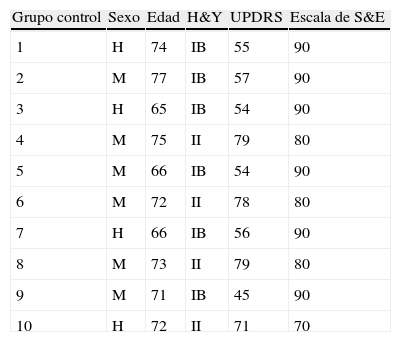El objetivo del presente trabajo fue demostrar la efectividad de un programa de fisioterapia combinado con estímulos sensoriales sobre los trastornos de la marcha en pacientes con enfermedad de Parkinson (EP).
Material y métodosParticiparon en el estudio 24 pacientes con estadios IB-II según la escala de Hoehn y Yahr. Aleatoriamente, fueron distribuidos en un grupo control, que recibió tratamiento de fisioterapia, y un grupo experimental, el cual recibió el mismo tratamiento y entrenamiento de la marcha mediante estímulos sensoriales con un metrónomo digital. El estudio tuvo una duración de 32 semanas. Antes y al finalizar el programa se analizó el Test Timed Up and Go como variable resultado.
ResultadosLos grupos no mostraron diferencias significativas a nivel basal. El ANOVA determinó una interacción entre tiempo * grupo (F = 35,874; p < 0,001) para el tiempo durante el test: el grupo experimental mostró una disminución mayor del tiempo necesario para completar el test tras el tratamiento, comparado con el grupo control. El efecto clínico intragrupal fue largo tanto para el grupo experimental (d: 2,8; IC del 95%, 3,5-2,2) como para el grupo control (d: 2,2; IC del 95%, 1,3-2,7). El efecto clínico intergrupal fue largo (d: 6,1; IC del 95%, 4,0-8,2) a favor del grupo experimental.
ConclusionesUn programa de fisioterapia grupal, junto con estímulos sensoriales auditivos para la reeducación de la marcha produce una mejoría significativa sobre los trastornos del equilibrio dinámico y la movilidad funcional en sujetos con EP.
The aim of this study was to demonstrate the effectiveness of a physiotherapy program combined with sensory stimuli on gait disorders in patients with Parkinson's disease.
Material and methodsA total of 24 patients with stage IB-II according to Hoehn and Yahr scale participated in the study. They were randomly distributed into a control group that received standard physiotherapy treatment and an experimental group that received the same physiotherapy along with gait training by sensory stimuli with a digital metronome. The study lasted 32 weeks. Timed Up and Go Test was analyzed before and after the program as outcome variable.
ResultsThe groups showed no statistically significant differences at baseline. ANOVA identified an interaction between time * group (F = 35.874, P<.001) for the time during the test. The experimental group showed a greater reduction in the time needed to complete the test after treatment compared to the control group. The intra-group clinical effect was long for both the experimental group (d: 2.8, 95% CI 3.5 to 2.2) and for the control group (d: 2.2, 95% CI 1.3 - 2.7). The inter-group clinical effect was longer (d: 6.1, 95% CI 4.0 to 8.2) in the experimental group.
ConclusionsA physical therapy program group combined with auditory sensorial stimuli for rehabilitation of gait produces a significant improvement on the dynamic balance disorders and functional mobility in patients with PD in early stages of the disease.
Artículo
Si ya tiene sus datos de acceso, clique aquí.
Si olvidó su clave de acceso puede recuperarla clicando aquí y seleccionando la opción "He olvidado mi contraseña".Comprando el artículo el PDF del mismo podrá ser descargado
Precio 19,34 €
Comprar ahora









